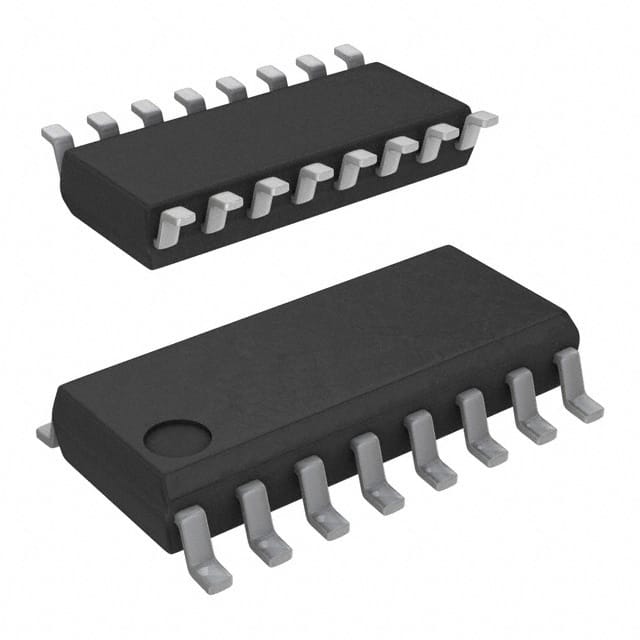Lihat spesifikasi untuk detail produk.

CD74HC138M96
Product Overview
- Category: Integrated Circuit
- Use: Decoding and demultiplexing
- Characteristics: High-speed operation, low power consumption
- Package: 16-pin SOIC package
- Essence: CD74HC138M96 is a 3-to-8 line decoder/demultiplexer IC that converts binary information from input lines into output lines.
- Packaging/Quantity: Available in reels of 2500 units
Specifications
- Supply Voltage: 2V to 6V
- High-Level Input Voltage: 2V to VCC
- Low-Level Input Voltage: GND to 0.8V
- High-Level Output Current: -4mA
- Low-Level Output Current: 4mA
- Operating Temperature Range: -40°C to +85°C
Detailed Pin Configuration
The CD74HC138M96 has a total of 16 pins, which are as follows:
- A0: Address input 0
- A1: Address input 1
- A2: Address input 2
- E1: Enable input 1
- E2: Enable input 2
- E3: Enable input 3
- Y0: Output 0
- Y1: Output 1
- Y2: Output 2
- Y3: Output 3
- Y4: Output 4
- Y5: Output 5
- Y6: Output 6
- Y7: Output 7
- VCC: Positive supply voltage
- GND: Ground
Functional Features
- Converts 3-bit binary input into 8-line outputs
- Active LOW enable inputs for easy control
- High-speed operation allows for quick decoding and demultiplexing
- Low power consumption makes it suitable for battery-powered devices
Advantages and Disadvantages
Advantages
- Compact size and easy integration into electronic circuits
- High-speed operation enables efficient data processing
- Low power consumption prolongs battery life in portable devices
- Versatile application in various digital systems
Disadvantages
- Limited number of input lines (3-bit)
- May require additional components for complex applications
Working Principles
The CD74HC138M96 operates based on the principle of binary decoding. The three address inputs (A0, A1, and A2) receive binary information, which is then decoded to activate one of the eight output lines (Y0 to Y7). The enable inputs (E1, E2, and E3) control the operation of the decoder/demultiplexer.
Detailed Application Field Plans
The CD74HC138M96 finds extensive use in digital systems that require decoding and demultiplexing functions. Some specific application areas include:
- Address decoding in microcontrollers and microprocessors
- Memory selection in computer systems
- Data routing in communication networks
- Signal demultiplexing in audio/video equipment
- Control signal generation in industrial automation
Detailed and Complete Alternative Models
- SN74LS138: Similar 3-to-8 line decoder/demultiplexer IC with different package options
- CD4514: 4-to-16 line decoder/demultiplexer IC for more complex applications
- 74HC238: 3-to-8 line decoder/demultiplexer IC with higher speed and lower power consumption
(Note: This list is not exhaustive and other alternative models may exist.)
In conclusion, the CD74HC138M96 is a versatile integrated circuit that provides efficient decoding and demultiplexing capabilities. Its compact size, high-speed operation, and low power consumption make it suitable for various digital systems. However, its limited number of input lines may require additional components for complex applications.
Sebutkan 10 pertanyaan dan jawaban umum terkait penerapan CD74HC138M96 dalam solusi teknis
Sure! Here are 10 common questions and answers related to the application of CD74HC138M96 in technical solutions:
Q: What is CD74HC138M96? A: CD74HC138M96 is a 3-to-8 line decoder/demultiplexer integrated circuit (IC) that can be used in various digital logic applications.
Q: What is the purpose of CD74HC138M96? A: The purpose of CD74HC138M96 is to decode a binary input and select one of the eight output lines based on the input value.
Q: What voltage levels does CD74HC138M96 support? A: CD74HC138M96 supports voltage levels ranging from 2V to 6V, making it compatible with both TTL and CMOS logic families.
Q: How many inputs does CD74HC138M96 have? A: CD74HC138M96 has three binary inputs (A0, A1, and A2) that determine which output line is selected.
Q: How many output lines does CD74HC138M96 have? A: CD74HC138M96 has eight output lines (Y0-Y7) that can be individually selected based on the input values.
Q: Can CD74HC138M96 be cascaded to increase the number of output lines? A: Yes, multiple CD74HC138M96 ICs can be cascaded together to increase the number of output lines by using the outputs of one IC as inputs for another.
Q: What is the maximum current that CD74HC138M96 can source or sink? A: CD74HC138M96 can source or sink up to 4mA of current per output pin.
Q: What is the propagation delay of CD74HC138M96? A: The typical propagation delay of CD74HC138M96 is around 13ns, making it suitable for high-speed applications.
Q: Can CD74HC138M96 be used in both active-high and active-low configurations? A: Yes, CD74HC138M96 can be used in both active-high and active-low configurations by connecting the appropriate input signals.
Q: What are some common applications of CD74HC138M96? A: CD74HC138M96 is commonly used in address decoding, memory selection, data routing, and general-purpose digital logic circuits.
Please note that these answers are general and may vary depending on specific use cases and requirements.

